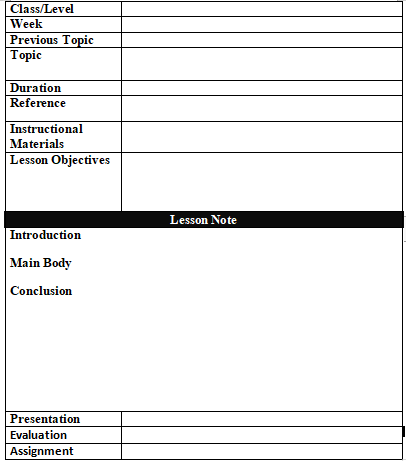The purpose of this article is to show you the parts of a lesson plan. You can download the lesson plan template editable at the end of this article. A lesson plan, usually prepared in advance is a teacher’s daily guide for what students need to learn, how it will be taught, and how learning will be measured. Lesson plans help teachers be more effective in the classroom by providing a detailed outline to follow each class period.
Lesson planning is an activity that the teacher performs before the actual lesson takes place. A lesson plan is a detailed description of the instructional strategies and learning activities to be performed during the teaching/learning process. See 26 Qualities Of A Good Lesson Plan
The importance of lesson plan
- A well-prepared lesson plan gives the teacher a sense of direction when he enters the classroom.
- A lesson plan helps the teacher to know when and where to start and where to stop.
- It allows the teacher to know which materials would be needed so that they are collected before the class.
- In case of illness, the lesson plan of a teacher could be used by another teacher to teach the class.
- It serves as a record for the teacher in the future.
- It also guides the teacher as to what instrument to use for evaluation.
What are the parts of a Lesson Plan?
Lesson objective:
The lesson objective is a part of a Lesson Plan that is usually written as a single sentence. A lesson objective is a very general statement of what the overall goal is in a lesson – the intention behind the teaching. A learning objective should describe what students should know or be able to do at the end of the class that they couldn’t do before.
Reference/Source:
Reference means the sources of information that enabled you to build the lesson content. They can include textbooks, dictionaries, grammar books, newspapers, blogs, research papers etc. If your lesson plan can be accessed by your student, your reference can help them read further after class.
Instructional Material:
These are also known as teaching aids. These are tools or resources used by a teacher to enhance or enliven classroom instruction. They hold the power to either engage or demotivate students. Instructional materials are objects (such as a book, picture, or map) or devices (such as a DVD or computer). They could be audiovisual teaching aids such as videos and guest lectures or tactile like 3D models.
Lesson Content:
This is the content area of your lesson plan and one of the most important parts of a lesson plan. It consists of the subject topic introduction, the main body, and the conclusion of what is expected to be learned which forms the basis of teaching and learning.
Presentation:
This is another part of a lesson plan that is very important. In a lesson plan, the nature of the subject topic always determines the presentation. It could be primarily theoretical, practical, or a combination. The purpose of a presentation is to ensure that the lesson objective is carried out without deviation. The presentation should clearly state the step-by-step teaching process.
Evaluation
This is that part of a lesson plan used for weighing in on student understanding of what has been taught. In a lesson plan, evaluation determines whether the objectives of the lesson have been met. Summative evaluation is the most widely used form of evaluation.
Assignment:
In a lesson plan, an assignment is another form of evaluation that is done to make them practice at home and at the same time make them remain on track until the next lesson.

